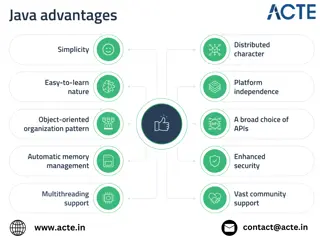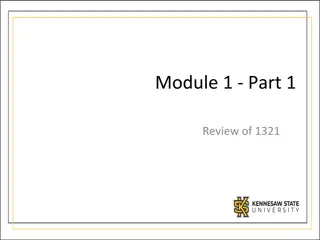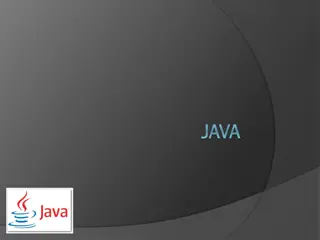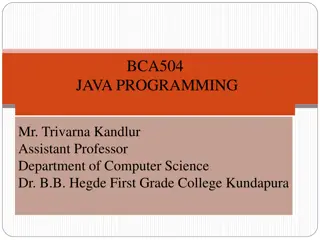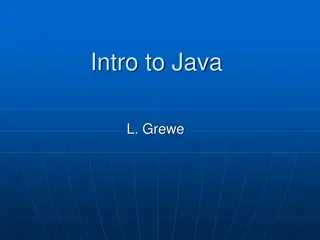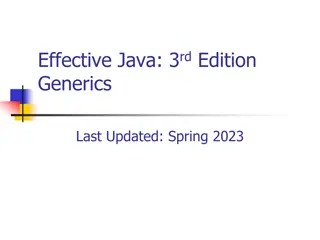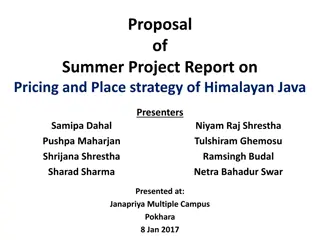Understanding Java Data Types and Variable Declaration
Dive into the world of Java data types and variable declaration with this comprehensive guide. Learn about primitive data types, declaring variables, integer types, floating-point data types, character data type, and boolean data type. Master the art of assigning names and data types to efficiently manage memory allocation and data storage in your Java programming endeavors.
Download Presentation

Please find below an Image/Link to download the presentation.
The content on the website is provided AS IS for your information and personal use only. It may not be sold, licensed, or shared on other websites without obtaining consent from the author. Download presentation by click this link. If you encounter any issues during the download, it is possible that the publisher has removed the file from their server.
E N D
Presentation Transcript
CHAPTER 4 GC 101 Data types
DATA TYPES For all data, assign a name (identifier) and a data type Data type tells compiler: How much memory to allocate Format in which to store data Types of operations you will perform on data Java "primitive data types" byte, short, int, long, float, double, char, boolean
DECLARING VARIABLES Variables hold one value at a time, but that value can change Syntax: dataType identifier; or dataType identifier1, identifier2, ; Naming convention for variable names: first letter is lowercase embedded words begin with uppercase letter
Declaring Variables Names of variables should be meaningful and reflect the data they will store This makes the logic of the program clearer Don't skimp on characters, but avoid extremely long names Avoid names similar to Java keywords
1) INTEGER TYPES - WHOLE NUMBERS TypeSize in Bytes Minimum Value Maximum Value byte 1 -128 127 short 2 -32,768 32,767 int 4 -2, 147, 483, 648 2, 147, 483, 647 long 8 -9,223,372,036,854,775,808 9,223,372,036,854,775,807 Example declarations: int testGrade; int numPlayers, highScore, diceRoll; short xCoordinate, yCoordinate; byte ageInYears; long cityPopulation;
2) FLOATING-POINT DATA TYPES Numbers with fractional parts TypeSize Minimum Value Maximum Value in Bytes float 4 1.4E-45 3.4028235E38 double 8 4.9E-324 1.7976931348623157E308 Example declarations: float salesTax; double interestRate; double paycheck, sumSalaries;
3) CHAR DATA TYPE One Unicode character (16 bits - 2 bytes) TypeSize Minimum Value Maximum Value in Bytes char 2 character character encoded as 0 encoded as FFFF Example declarations: char finalGrade; char newline, tab, doubleQuotes;
4) BOOLEAN DATA TYPE Two values only: true false Used for decision making or as "flag" variables Example declarations: boolean isEmpty; boolean passed, failed;
ASSIGNING VALUES TO VARIABLES Assignment operator = Value on the right of the operator is assigned to the variable on the left Value on the right can be a literal (text representing a specific value), another variable, or an expression (explained later) Syntax: int num1 = 1 ,num2= 5; int num3 = num1; int sum=num1+num2+num3; dataType variableName = initialValue; Or dataType variable1 = initialValue1, variable2 = initialValue2, ; float salary= 0.0, Rate = 1.5;
ASSIGNING THE VALUES OF OTHER VARIABLES Syntax: dataType variable2 = variable1; Rules: 1. variable1 needs to be defined before this statement appears in the source code 2. variable1 and variable2 need to be compatible data types.
COMPATIBLE DATA TYPES Any type in right column can be assigned to type in left column: Data TypeCompatible Data Types byte byte short byte, short int byte, short, int, char long byte, short, int, long, char float float, byte, short, int, long, char double float, double, byte, short, int, long, char boolean boolean char char
SAMPLE ASSIGNMENTS This is a valid assignment: float salesTax = .05; double taxRate = salesTax; This is invalid because the float data type is lower in precision than the double data type: float salesTax = taxRate;
STRING LITERALS String is actually a class, not a basic data type; String variables are objects String literal: text contained within double quotes. Example of String literals: "Hello" "Hello world" "The value of x is "
STRING CONCATENATION OPERATOR (+) Combines String literals with other data types for printing Example: String h = "Hello"; String t = "there"; String greeting = h + ' ' + t; System.out.println( greeting ); Output is: Hello there
COMMON ERROR String literals must start and end on the same line. This statement: System.out.println( "Never pass a water fountain without taking a drink" ); generates these compiler errors: unclosed string literal ')' expected Break long Strings into shorter Strings and use the concatenation operator: System.out.println( "Never pass a water fountain" + " without taking a drink" );
ESCAPE SEQUENCES To include a special character in a String, use an escape sequence Character Escape Sequence Newline \n Tab \t Double quotes \" Single quote \' Backslash \\ Backspace \b Carriage return \r Form feed \f
Once a variable is declared, its data type cannot be changed. Declare a variable only once These statements: double twoCents; These statements: double twoCents = .02; double cashInHand; generate this compiler error: int cashInHand; twoCents is already defined generate this compiler error: cashInHand is already defined
CONSTANTS Value cannot change during program execution Syntax: final dataType constantIdentifier = assignedValue; Note: assigning a value when the constant is declared is optional. But a value must be assigned before the constant is used.
Use all capital letters for constants and separate words with an underscore: Example: final double TAX_RATE = .05; Declare constants at the top of the program so their values can easily be seen Declare as a constant any data that should not change during program execution
ASSIGNMENT OPERATOR Syntax: target = expression; expression: operators and operands that evaluate to a single value --value is then assigned to target --target must be a variable (or constant) --value must be compatible with target's data type
EXAMPLES: int numPlayers = 10; // numPlayers holds 10 numPlayers = 8; // numPlayers now holds 8 int legalAge = 18; int voterAge = legalAge; The next statement is illegal int height = weight * 2; // weight is not defined int weight = 20; and generates the following compiler error: illegal forward reference
ARITHMETIC OPERATORS Operator Operation + addition - subtraction * multiplication / division % modulus (remainder after division)
OPERATOR PRECEDENCE Operator Order of Operation evaluation left - right parenthesis for explicit grouping left - right multiplication, division, modulus left - right addition, subtraction right - left assignment ( ) * / % + - =
EXAMPLE int pennies = 2 * 25 + 3 * 10 + 2 * 5; = 50 + 3 * 10 + 2 * 5; = 50 + 30 + 2 * 5; = 50 + 30 + 10 = 80 + 10 = 90
ANOTHER EXAMPLE Translate ? 2? into Java: // incorrect! double result = x / 2 * y; => x * y 2 // correct double result = x / ( 2 * y );
INTEGER DIVISION & MODULUS When dividing two integers: the quotient is an integer the remainder is truncated (discarded) To get the remainder, use the modulus operator with the same operands
DIVISION BY ZERO Integer division by 0: Example: int result = 4 / 0; No compiler error, but at run time, JVM generates ArithmeticException and program stops executing Floating-point division by 0: If dividend is not 0, the result is Infinity If dividend and divisor are both 0, the result is NaN (not a number)
SHORTCUT OPERATORS ++ increment by 1 -- decrement by 1 Example: count++; // count = count + 1; count--; // count = count - 1; Postfix version (var++, var--): use value of var in expression, then increment or decrement. Prefix version (++var, --var): increment or decrement var, then use value in expression
MORE SHORTCUT OPERATORS Operator Example Equivalent += a += 3; a = a + 3; -= a -= 10; a = a - 10; *= a *= 4; a = a * 4; /= a /= 7; a = a / 7; %= a %= 10; a = a % 10;
COMMON ERROR TRAP No spaces are allowed between the arithmetic operator and the equals sign Note that the correct sequence is +=, not =+ Example: add 2 to a // incorrect a =+ 2; // a = +2; assigns 2 to 2 // correct a += 2; // a = a + 2;
OPERATOR PRECEDENCE Operator Order of evaluation left - right Operation ( ) parenthesis for explicit grouping ++ -- right - left preincrement, predecrement ++ -- right - left postincrement, postdecrement * / % left - right multiplication, division, modulus + - left - right addition or String concatenation, subtraction assignment = += -= *= /= %= right - left




